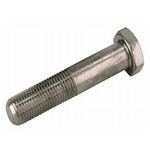
Grade 2-Plated 1/4-20 x 1" Hex Bolts
This article is part of a series covering “The Nuts and Bolts” of common fasteners used in everyday projects. We’ll cover what the fastener is, typical applications, available materials and strengths, head types, sizes, and other helpful information.
Typical Use
Hex bolts, are used on construction projects where materials need to be secured together; such as mounting a bicycle seat, putting together a swing set or building a boat dock. They’re fastened in place with hex nuts. A wrench is often used to tighten the nut to the bolt with an appropriate amount of torque. Flat washers may also be used to help seat the bolt and cover any excess space/gap between the hole the bolt is going through and the bolt head. Lock washers, while also helping to seat the bolt and cover gaps, also help keep the assembly from shifting.
Sizing

Hex bolt sizing chart

Hex bolt sizing chart
Hex bolt diameter is expressed by both the shank diameter, then the threads per inch. For example, a typical hex bolt with a 1/4″ shank diameter and 20 threads per inch would be conveyed as “1/4 -20″. Typical diameters range from 1/4″ to 2″.
The length of hex bolts is measured from the top of the shank (just below the head) to the tip of the shank. Typical lengths range from 1/4″ to 30″. Larger sizes of both the diameter and length can be special ordered.
Threading

Hex bolts are manufactured in two gauges: fine and coarse-threaded. The number “20″ in the 1/4-20 hex bolt example above is coarse-threaded and indicates that there are 20 threads per inch. Conversely, a 1/4-28 hex bolt is fine-threaded, indicating there are 28 threads per inch. Thus, coarse-threaded bolts will always have less threads per inch than fine-threaded. You can read more about Coarse vs. Fine threading here.
Head Types
Square Head
Hex bolts have a hexagonal head, replacing the old style square head bolts from years past.
Materials / Strengths
Hex bolts are offered in a variety of materials, which have varying degrees of strength. Here is a list of materials, from lowest to highest grade strength: low carbon, grade 2, medium carbon, heat treated, grade 5, high strength, grade 8, structural steel, A325 & A490, along with multiple grades of stainless steel materials, which you can read more about here.

